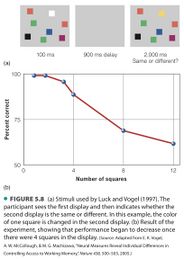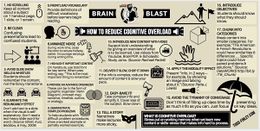Capacity Limitations Principle: Difference between revisions
| (22 intermediate revisions by 2 users not shown) | |||
| Line 5: | Line 5: | ||
=== Evidence === | === Evidence === | ||
[[File:Figure 5.8.jpeg|Figure 5.8|260x260px|right|'''Figure 5.8''']] | [[File:Figure 5.8.jpeg|Figure 5.8|260x260px|right|'''Figure 5.8''']] | ||
The human brain can only hold a limited amount of information at any given time. Graphical or other informational displays should not require the reader to hold more than 4 perceptual groups in mind at once (Kosslyn, 2006). Recent studies about the capacity of working memory have established the capacity at around 4 items (Goldstein 2021). One experiment by Steven Luck and Edward Vogel (1997) measures the capacity of working memory by flashing two arrays of colored squares separated by a brief delay. The color of one square is changed on trails where the second array is different. The task given to participants was to determine whether the color of the square in the second array is different from the color in the first array. The result of this experiment demonstrates the participants’ performance as close to perfection when 1 to 3 squares are shown in the arrays. However, when there are 4 or more colored squares shown in the arrays, the performance of participants begins to decrease. The decline in participant performance continues as more squares are shown. From the result of this experiment, Luck and Vogel concluded that the short term memory is capable of retaining about 4 items at one time | The human brain can only hold a limited amount of information at any given time. Graphical or other informational displays should not require the reader to hold more than 4 perceptual groups in mind at once (Kosslyn, 2006). Recent studies about the capacity of working memory have established the capacity at around 4 items (Goldstein 2021). One experiment by Steven Luck and Edward Vogel (1997) measures the capacity of working memory by flashing two arrays of colored squares separated by a brief delay. The color of one square is changed on trails where the second array is different. The task given to participants was to determine whether the color of the square in the second array is different from the color in the first array. The result of this experiment demonstrates the participants’ performance as close to perfection when 1 to 3 squares are shown in the arrays. However, when there are 4 or more colored squares shown in the arrays, the performance of participants begins to decrease. The decline in participant performance continues as more squares are shown. From the result of this experiment, Luck and Vogel concluded that the short term memory is capable of retaining about 4 items at one time. | ||
=== Examples === | === Examples === | ||
| Line 11: | Line 11: | ||
Below are two examples of cognitive overload taking place when the design of graphics and informational displays fails to follow The Principle of Capacity Limitations. | Below are two examples of cognitive overload taking place when the design of graphics and informational displays fails to follow The Principle of Capacity Limitations. | ||
• This image is from https:// | • This image is from the article https://www.theedadvocate.org/17-ways-to-prevent-cognitive-overload-in-your-students/ | ||
[[File:DakwsobXcAA4jBM.jpeg|thumb right|260x260px|'''Image 2''']] | [[File:DakwsobXcAA4jBM.jpeg|thumb right|260x260px|'''Image 2''']] | ||
| Line 23: | Line 19: | ||
[[File:Image_2.png|thumb right|260x260px|'''Image 3''']] | [[File:Image_2.png|thumb right|260x260px|'''Image 3''']] | ||
Both images include amounts of information that exceeds the maximum capacity of the working memory. | Both images include amounts of information that exceeds the maximum capacity of the working memory. Viewers of the images above are unlikely to understand all of the given messages as it is infeasible for them to retain and process the excessive information. | ||
=== Design Implications === | === Design Implications === | ||
| Line 30: | Line 26: | ||
Here are a few tips to do that: | Here are a few tips to do that: | ||
1. Avoid putting an excessive amount of information in a single message. The quantity of information contained in one graph or display should not exceed the capacity of the working memory. Designers should avoid incorporating more than 4 items or clusters of information in one single display. | 1. Avoid putting an excessive amount of information in a single message. The quantity of information contained in one graph or display should not exceed the capacity of the working memory. Designers should avoid incorporating more than 4 items or clusters of information in one single display. For example, when designing a user interface for a software application, it is good to limit the number of menu items or options on a screen to a level that the user can process and remember effectively. Similarly, when designing a PowerPoint presentation, designers can limit the number of slides to a level that the audience can process and remember effectively. | ||
2. Chucking. Chucking refers to combining several smaller units of knowledge into a larger meaningful and relevant unit. This allows our working memory to hold more information. Incorporating the chucking method in designs allows the designer to include more information into the display without causing cognitive overload. | 2. Chucking. Chucking refers to combining several smaller units of knowledge into a larger meaningful and relevant unit. This allows our working memory to hold more information. Incorporating the chucking method in designs allows the designer to include more information into the display without causing cognitive overload. | ||
3. [ | 3. [https://ectwiki.online/index.php?title=Multimedia_Principle The Multimedia Principle]. The Multimedia Principle states that people learn better when words and pictures are presented simultaneously than from words alone. When a design incorporates The Multimedia Principle, the learners can retain and process the information displayed better and easier. This accounts for the limited capacity of the working memory and reduces the chances of cognitive overload. | ||
=== Challenges === | |||
1. Determining the limits of cognitive processing: | |||
Although the maximum capacity of short-term memory is around 4 items of information at a time, the specific cognitive limit for each individual is difficult to determine. The specific limit of each individual learner's cognitive processing can vary based on factors including age, experience, prior knowledge, and task demands. It can be difficult to accurately predict the limits of cognitive processing in a given context, and this can make it challenging to apply the principle effectively. | |||
2. Balancing simplicity and completeness: | |||
Another challenge is balancing the need for simplicity with the need for completeness. On one hand, it is important to limit the amount of information displayed in a display to a level that the viewer can process and remember effectively. On the other hand, it is also important to ensure that the display includes all of the necessary and relevant information needed to convey the intended message or achieve the desired outcome. It can be challenging to follow The Principle of Capacity Limitations when the amount of information required to successfully convey the intended message is beyond the anticipated capacity of the working memory. | |||
3. Dealing with complex or unfamiliar information: | |||
A third challenge is dealing with complex or unfamiliar information, as it can be difficult for the viewer to accurately perceive and understand this type of information. In these cases, it may be necessary to use additional design strategies, such as providing context or background information, or breaking the information down into smaller, more manageable chunks. | |||
=== References === | === References === | ||
Latest revision as of 19:06, 16 December 2022
Overview[edit | edit source]
The principle of capacity limitations is a concept in cognitive science that states the design of graphics and displays should take account of the limited capacity people have in their working memory and attention to retain and process information. If a message contains excessive information that exceeds people’s capacity to retain and process, it would not to be understood. This principle is commonly used in psychology and other fields to understand and explain why people may struggle with certain tasks or activities. It is based on the idea that people’s abilities are not unlimited and there are limits to what they can do. For example, a person’s working memory has a small and limited capacity, making it difficult to remember a long list of items. Due to the nature of limited capacity in people’s working memory and attention, designs of graphics and displays should contain information that does not exceed the maximum capacity to retain and process. When failing to do so, people will experience cognitive overload and fail to understand the information.
Evidence[edit | edit source]
The human brain can only hold a limited amount of information at any given time. Graphical or other informational displays should not require the reader to hold more than 4 perceptual groups in mind at once (Kosslyn, 2006). Recent studies about the capacity of working memory have established the capacity at around 4 items (Goldstein 2021). One experiment by Steven Luck and Edward Vogel (1997) measures the capacity of working memory by flashing two arrays of colored squares separated by a brief delay. The color of one square is changed on trails where the second array is different. The task given to participants was to determine whether the color of the square in the second array is different from the color in the first array. The result of this experiment demonstrates the participants’ performance as close to perfection when 1 to 3 squares are shown in the arrays. However, when there are 4 or more colored squares shown in the arrays, the performance of participants begins to decrease. The decline in participant performance continues as more squares are shown. From the result of this experiment, Luck and Vogel concluded that the short term memory is capable of retaining about 4 items at one time.
Examples[edit | edit source]
Below are two examples of cognitive overload taking place when the design of graphics and informational displays fails to follow The Principle of Capacity Limitations.
• This image is from the article https://www.theedadvocate.org/17-ways-to-prevent-cognitive-overload-in-your-students/
• This image is from https://www.arngren.net/
Both images include amounts of information that exceeds the maximum capacity of the working memory. Viewers of the images above are unlikely to understand all of the given messages as it is infeasible for them to retain and process the excessive information.
Design Implications[edit | edit source]
It is important that graphic and contextual designs follow The Principle of Capacity Limitations and take account of the limited capacity of people’s working memory. Here are a few tips to do that:
1. Avoid putting an excessive amount of information in a single message. The quantity of information contained in one graph or display should not exceed the capacity of the working memory. Designers should avoid incorporating more than 4 items or clusters of information in one single display. For example, when designing a user interface for a software application, it is good to limit the number of menu items or options on a screen to a level that the user can process and remember effectively. Similarly, when designing a PowerPoint presentation, designers can limit the number of slides to a level that the audience can process and remember effectively.
2. Chucking. Chucking refers to combining several smaller units of knowledge into a larger meaningful and relevant unit. This allows our working memory to hold more information. Incorporating the chucking method in designs allows the designer to include more information into the display without causing cognitive overload.
3. The Multimedia Principle. The Multimedia Principle states that people learn better when words and pictures are presented simultaneously than from words alone. When a design incorporates The Multimedia Principle, the learners can retain and process the information displayed better and easier. This accounts for the limited capacity of the working memory and reduces the chances of cognitive overload.
Challenges[edit | edit source]
1. Determining the limits of cognitive processing: Although the maximum capacity of short-term memory is around 4 items of information at a time, the specific cognitive limit for each individual is difficult to determine. The specific limit of each individual learner's cognitive processing can vary based on factors including age, experience, prior knowledge, and task demands. It can be difficult to accurately predict the limits of cognitive processing in a given context, and this can make it challenging to apply the principle effectively.
2. Balancing simplicity and completeness: Another challenge is balancing the need for simplicity with the need for completeness. On one hand, it is important to limit the amount of information displayed in a display to a level that the viewer can process and remember effectively. On the other hand, it is also important to ensure that the display includes all of the necessary and relevant information needed to convey the intended message or achieve the desired outcome. It can be challenging to follow The Principle of Capacity Limitations when the amount of information required to successfully convey the intended message is beyond the anticipated capacity of the working memory.
3. Dealing with complex or unfamiliar information: A third challenge is dealing with complex or unfamiliar information, as it can be difficult for the viewer to accurately perceive and understand this type of information. In these cases, it may be necessary to use additional design strategies, such as providing context or background information, or breaking the information down into smaller, more manageable chunks.
References[edit | edit source]
1. Kosslyn, S. M. (2006). Graph design for the eye and mind. https://doi.org/10.1093/acprof:oso/9780195311846.001.0001
2. Goldstein, E. B. (2021). Cognitive psychology: Connecting mind, research, and everyday experience. Cengage.
3. Luck, S. J., & Vogel, E. K. (1997). The capacity of visual working memory for features and conjunctions. Nature, 390(6657), 279–281. https://doi.org/10.1038/36846



